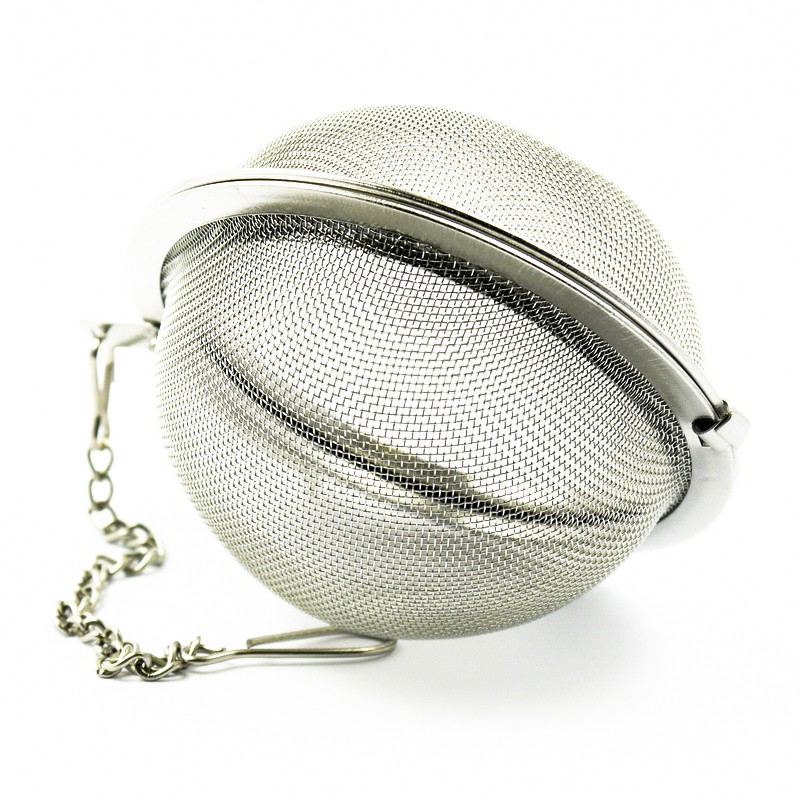Gifts And Accessories

Gifts
The ideal present for aficionados of tea and coffee would be a £10, £25 or £50 gift card or one of our gift selections.

Accessories
Our selection of accessories. Our range includes filters, strainers, and infusers. Also an array of tea caddy accessories.

Hampers
Our tea and coffee hampers make the perfect gifts, thoughtfully curated with a selection of fine teas and gourmet coffees.
About Product
-
Product Description
Brew your favourite Loose Leaf Tea with our Mesh Infuser (Large). Its size ensures a hearty cuppa’ with every sip. This product, like all of our Loose Leaf Tea utensils, has our guarantee of exceptional quality. And with quality utensils comes quality Tea!
Loose Leaf Tea has again taken the world by storm. This comes after a long period when Tea Bags ruled supreme. Mark their return in excellent fashion with our Mesh Infuser (Large). After that, explore our range of delicious Loose Teas here at The Kent and Sussex Tea and Coffee Company. Best of all, we pack everything fresh to order.
Mesh Infuser (Large) Measurements: size – 6.5 cm diameter.
Which Tea Should I Drink?
At first, it might be a little daunting looking at our 1,000 types of Tea. You might be asking yourself the question: “which Tea should I drink?”. With this Mesh Infuser (Large), you will be looking to drink Loose Leaf Tea as a start. But even then, which one suits your palate best? Let’s explore!
The four main types of Tea are Black Tea, Green Tea, White Tea and Oolong Tea. These all come from the same Camellia sinensis (Tea) plant. The difference between each of them lies in the processing method applied to the leaves.
Herbal Teas and Fruit Tisanes, on the other hand, do not come from the Camellia sinensis plant. For this reason, they’re not technically ‘Teas’ in the conventional sense. However, the global Tea Industry has long ‘adopted’ them as honourary brews.
Black Tea
Following the withering and rolling of the leaf, Tea begins to ferment and oxidise. During oxidation, oxygen particles interact with the cell walls of the Tea leaves, turning them darker and darker until they are either brown or black.
Oxidation also alters the flavour profile of the Tea (which, at this stage, and by definition, is “Black Tea”) to accommodate distinct malty notes, sometimes even smokey or fruity notes depending on the Black Tea variety.
When most people in the West think of Tea, the image conjured is almost undoubtedly Black Tea. Why? Because from England to America; France to Australia, Black Tea is the most common type of Tea drunk in the western hemisphere. And it’s popularity is increasing at a rapid rate as more and more people are introduced to this remarkable, versatile and scrumptious beverage.
Green Tea
Green Tea is the least processed Tea type after White Tea. Soon after harvesting, producers quickly pan-fire or steam the leaves. This prevents too much oxidation occurring in the structure of the leaf. In preventing oxidation through either pan-firing or steaming, Green Tea maintains its freshness, grassiness and herbaceousness.
Following the initial pan-firing/steaming stage, Green Tea must undergo the rolling process. This involves the Tea leaves being broken up and then rolled into a unique shape. Finally, producers dry the Green Tea to reduce the moisture content from approximately 10-13% to 5%.
No one can deny the significant cultural and historical impact of Green Tea. To many, this Tea is Tea in its truest form. Green Tea has presented itself as a bedrock of society in much of the Eastern world. Today, it is taking the West by storm as well.
Oolong Tea
Many see Oolong Tea as the “in-between” Tea. This is because its fermentation and oxidation levels lie somewhere in the middle of Green Tea and Black Tea. Some Tea connoisseurs think its tasting notes lie somewhere in this middle-ground, too.
In truth, no two Oolong Teas are the same. Producers creating Oolong Tea ultimately determine the desired oxidation levels, which can vary from 8% oxidation to 80% oxidation. In other words, an Oolong Tea with 8% oxidation will boast characteristics reminiscent of Green Tea while one with 80% oxidation will offer notes much more like Black Tea.
However, less than 2% of the world’s Tea drinkers choose Oolong Tea. The reason for this is the lack of knowledge of its existence in the West. In China, meanwhile, this beverage has a nickname: Chinese Restaurant Tea. This is because many choose to drink it in restaurants for digestive relief.
White Tea
White Tea undergoes even less processing than Green Tea. This processing (or, rather, lack of), coupled with its short oxidation period, results in a brew that is delicate and very fresh. It also ensures that the Tea retains the vast majority of its antioxidants.
Contrary to popular belief, the name ‘White Tea’ does not come from the light liquor it produces. Instead, it stems from the silvery pekoe (hairs or dust) that grow on the unopened buds of the Tea leaf used in its making. The most common White Teas are Yinzhen (Silver Needle), Bai Mu Dan (White Peony) and Shou Mei.
Herbal Tea
A Herbal Tea can be anything from Peppermint to Camomile; Rooibos to Ginseng; or Lemongrass to Lemon Verbena. This is to name but a few, with many more waiting to be discovered. Most (not all) Herbal Teas have one thing in common: no caffeine.
Herbal Teas pre-date ‘real’ Teas by centuries. And for thousands of years, as well as still today, people have drunk them for their health benefits. Both Traditional Chinese Medicine and Indian Ayurveda have advocated the consumption of Herbal Tea since antiquity! Nowadays, modern science likewise supports the evidence that Herbal Tea can improve wellbeing.
Fruit Tisane
Similar to Herbal Teas, Fruit Tisanes pre-date ‘real’ Tea by hundreds of years. As the name suggests, these beverages consist of brewed fruits such as Peach Tisane Tea, Wild Berry Fruit Tea, Elderflower and Lemon Tea and even Boysenberry Fruit Tea.
Most people choose Fruit Tisanes for taste and taste alone. They can, however, be an excellent alternative to sugary beverages and soft drinks. Fruit Tisanes often contain few calories, which means they can, in their own way, support weight loss.
-
Delivery Information
We offer reliable delivery services through Royal Mail to ensure that your orders reach you on time.
Here are the main points you should be aware of:
- Standard UK Delivery: £3.95 excluding delivery charge.
- Delivery Times: Orders are processed and dispatched within 2-5 working days but they may take longer during busy times. It is worth noting that all our orders are packed by hand in order to maintain the quality.
- Free Delivery: We are delighted to provide free shipping for UK orders over £35*. Moreover, customers from Europe can enjoy free shipping for any purchase above €75*. Furthermore, we offer free delivery in the USA for all purchases exceeding $125*. Please note terms and conditions may apply.
- Tracking: When your package is sent you will receive a tracking number via email so as to keep tabs of its progress.
International Shipping
We do ship worldwide meaning our products can be accessed by anyone around the world.
Here are some important details:
- Delivery Times: International deliveries vary based on destination, generally taking between 7-14 working days.
- Shipping Costs: International shipping costs are calculated at checkout based on your location and weight of your order. View full delivery charges for your location.
- Customs and Import Duties: Remember customs or import duties may exist depending on regulations in your country; these charges are borne by the customer.
Returns Policy
Your satisfaction is our top priority, however if for any reasons you’re not completely happy with your purchase, simply follow our returns procedure:
- Eligibility: Items returned within 30 days of receipt must remain unopened and in their original condition.
- Process: In order to return an item contact our customer service department using your unique order number after which detailed instructions will be given concerning returning them back to us securely.
- Refunds: Our aim is to refund you within 5-7 working days upon successful reception of returned goods. The refund amount will be credited to your original payment method.
For any other Enquiries or help please contact our Customer Support Team always at your service.
-
Product Reviews

 Loose Leaf Tea
Loose Leaf Tea Pyramids
Pyramids Tea Bags
Tea Bags Africa
Africa Assam
Assam Ceylon
Ceylon Chinese
Chinese Darjeeling
Darjeeling European
European Indian
Indian Japan
Japan Nepal
Nepal South East Asia
South East Asia Ayurveda Tea
Ayurveda Tea Black Tea
Black Tea Chai Tea
Chai Tea Flowering Tea
Flowering Tea Fruit Tisanes
Fruit Tisanes Green Tea
Green Tea Herbal Tea
Herbal Tea Matcha Tea
Matcha Tea Oolong Tea
Oolong Tea Organic Tea
Organic Tea Pu erh Tea
Pu erh Tea Rooibos Tea
Rooibos Tea White Tea
White Tea Asian Coffee
Asian Coffee Caribbean Coffee
Caribbean Coffee Central American Coffee
Central American Coffee South American Coffee
South American Coffee Coffee Blends
Coffee Blends Decaffeinated Coffee
Decaffeinated Coffee Espresso Coffee
Espresso Coffee Ethically Sourced Coffee
Ethically Sourced Coffee Flavoured Coffee
Flavoured Coffee Organic Coffee
Organic Coffee Single Origin Coffee
Single Origin Coffee Chocolate 1
Chocolate 1 Chocolate 2
Chocolate 2 Chocolate 3
Chocolate 3 Chocolate 4
Chocolate 4 Chocolate 5
Chocolate 5 Chocolate 6
Chocolate 6 Chocolate 7
Chocolate 7 Chocolate 8
Chocolate 8 Chocolate 9
Chocolate 9 Loose Tea Filters
Loose Tea Filters Tea Accessories
Tea Accessories Tea Bricks
Tea Bricks Tea Caddies
Tea Caddies Tea Caddy Spoons
Tea Caddy Spoons Tea Gift Ideas
Tea Gift Ideas Tea Infusers
Tea Infusers Tea Strainers
Tea Strainers


